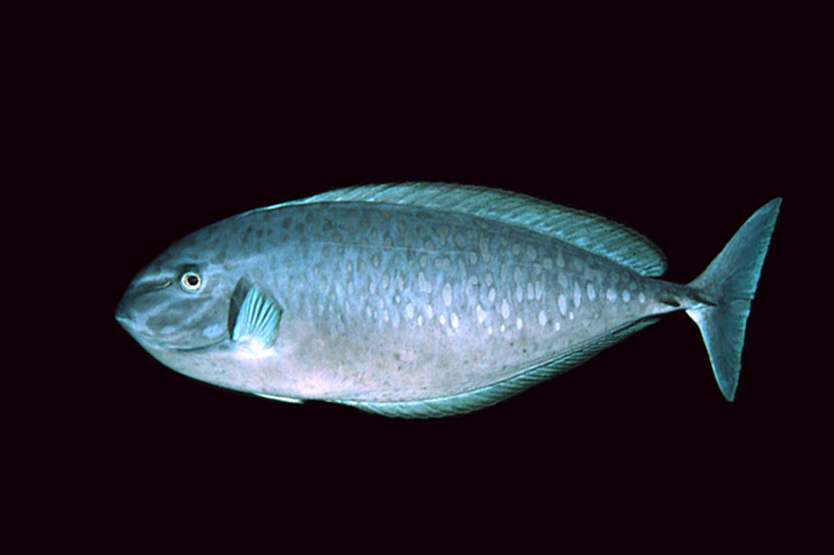Silverblotched Unicornfish, Naso caesius Randall & Bell 1992
Other Names: Gray Unicornfish, Grey Unicornfish, Silver-blotched Unicorn

A Silverblotched Unicornfish, Naso caesius, at Eniwetak Atoll, Marshall Islands. Source: John E. Randall / FishBase. License: CC by Attribution-NonCommercial
Summary:
A bluish-grey to dark brownish-grey surgeonfish with a bluish tail, and sometimes irregular vertical lighter or darker blotches on the sides.
The two keel-like spines on the elliptical bony plates on each side of caudal peduncle, are semicircular to subquadrangular when viewed from above (not sharply pointed with the tip projecting forward, as in Naso hexacanthus).
The two keel-like spines on the elliptical bony plates on each side of caudal peduncle, are semicircular to subquadrangular when viewed from above (not sharply pointed with the tip projecting forward, as in Naso hexacanthus).
Cite this page as:
Bray, D.J. 2022, Naso caesius in Fishes of Australia, accessed 19 Apr 2024, https://fishesofaustralia.net.au/Home/species/1037
Silverblotched Unicornfish, Naso caesius Randall & Bell 1992
More Info
|
Distribution |
Off shore reefs of north Western Australia, Ashmore Reef in the Timor Sea, and the northern Great Barrier Reef, Queensland, and reefs in the Coral Sea, to the Kurnell Peninsula, New South Wales, and the Lord Howe Province in the Tasman Sea; also Cocos (Keeling) Islands and Christmas Island in the eastern Indian Ocean. Elsewhere the species occurs in the tropical, west-central Pacific. Inhabits clear oceanic waters along steep dropoffs, offshore reefs and pinnacles. |
|
Features |
Dorsal fin VI-VII, 27-30; Anal fin II, 28-31; Pectoral fin 16-18, the upper two rays unbranched; Pelvic fin I, 3; Caudal fin (branched rays) 14; Gill rakers 3-5 + 8-11). Two elliptical bony plates on each side of caudal peduncle, each with a keel-like spine projecting laterally in adults, more in males than females; shape of peduncular spines semicircular to subquadrangular when viewed from above (not sharply pointed with the tip projecting forward. |
|
Colour |
Bluish grey, paler ventrally (almost white on some individuals); able to rapidly change to a pattern of vertically elongate blotches on about upper two-thirds of body, which may be either darker or paler than the ground colour (many blotches approximately elliptical, some irregular, and some interconnected); three pale bands may be present on head, one horizontal at level of upper edge of eye, and two diagonal on cheek; caudal fin more blue than body, without any distinct posterior border of different colour; pectoral rays somewhat yellowish. An occasional colour phase, also rapidly attained, is overall dark greyish-brown. |
|
Remarks |
This species is easily confused with Naso hexacanthus, and some records may be misidentified as N. hexacanthus. |
|
Similar Species |
Differs from the similar Naso hexcanthus in having smaller bladelike caudal spines that do not become sharply pointed and antrorse in large males, a pale tongue (vs. black in N. hexacanthus), overall bluish grey (vs. yellowish ventrally in N. hexacanthus), in lacking dark borders on the opercle and preopercle (present in N. hexacanthus). |
|
Etymology |
The specific name is from the Latin caesius (= bluish-grey) in reference to the overall colour of this species. |
|
Species Citation |
Naso caesius Randall & Bell, 1992, Pacific Science 46(3): 347, pl. IA-B, fig. 2. Type locality: Marshall Islands, Enewetak Atoll, north side of East Channel (main pass of the atoll) at wreck of concrete ship, 3-5 m. |
|
Author |
Bray, D.J. 2022 |
|
Resources |
Silverblotched Unicornfish, Naso caesius Randall & Bell 1992
References
Allen, G.R. & Erdmann, M.V. 2012. Reef fishes of the East Indies. Perth : Tropical Reef Research 3 vols, 1260 pp.
Borden, W.C. 1998. Phylogeny of the unicornfishes (Naso, Acanthuridae) based on soft anatomy. Copeia 1998(1): 104-113.
Oxley, W.G., Emslie, M., Muir, P. & Thompson, A.A. 2004. Marine surveys undertaken in the Lihou Reef National Nature Reserve, March 2004. Townsville : Australian Institute of Marine Science i-vii, 1-67 pp.
Randall, J.E. 2001. Zanclidae, Acanthuridae. pp. 3651-3683 in Carpenter, K.E. & Niem, T.H. (eds). The Living Marine Resources of the Western Central Pacific. FAO Species Identification Guide for Fisheries Purposes. Rome : FAO Vol. 6 pp. 3381-4218.
Randall, J.E., Allen, G.R. & Steene, R. 1997. Fishes of the Great Barrier Reef and Coral Sea. Bathurst : Crawford House Press 557 pp. figs.





